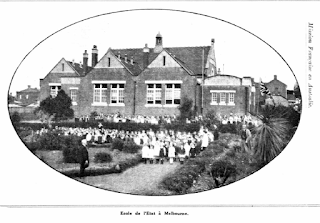Ship
Manlius, attrib. Fitz Henry Lane, c.1865
Charles Endersbee’s maternal great-grandfather, Horatio Wilks, was born
in Market Drayton in Shropshire. In April 1828 he was transported to Van Diemen’s
Land for 7 years. He had stolen fourteen hats from a warehouse. It was his
third conviction. He’d previously been in prison for stealing linen and stealing
marble.
Twenty-nine year old Horatio Wilks left behind his wife Rosanna and
children in their home city of Liverpool. Many years after his enforced voyage,
his daughter Caroline made her own way to Australia with two of her children.
It was 1856, thirty-two years after her father’s departure, and she was going to
join her husband Thomas Endersbee on the Victorian goldfields. It is not known
whether her father was still alive, or whether they ever met again.
It was not long before Thomas and Caroline Endersbee relocated to
the Newlands area of Coburg where Thomas is reputed to have set up as the first
quarryman in the area. Here they raised their family, including Thomas George,
who was our soldier Charles’ father.
Thomas Endersbee junior married Sarah Jane Daley at
Pentridge (as Coburg was then known) in October 1867 and they settled at 74
Bell Street, Coburg, just near the Public Hall and Shire Offices, where the
Moreland Municipal Offices are today. He was a warder at Pentridge and in those
times warders had to live within hearing distance of the bell at Pentridge, so
this was a perfect location. The seven Endersbee children, including Charles,
were raised in Bell Street.
In 1888, grandmother Caroline Endersbee (nee Wilks) died at West
Newlands and the year after grandfather Thomas died, leaving an estate of £1,152.
For the daughter of a convict, Caroline had done well. It is doubtful that the
family who stayed behind in England could say the same.
2900
Private Charles Endersbee, 32nd Infantry Battalion (on nominal roll. (51st
Btn, 7th Reinfs. on embarkation roll)
From the Coburg State School Soldiers' Book, page 30.
In 1903 Thomas Endersbee junior died and Charles, our
future soldier, lived at home for a while, before making his way to Western
Australia, where worked as a labourer on the railways. In 1916, he was living at the
257-Mile Camp, Trans-Australian Railway in the Kalgoorlie area. In July 1916,
aged 39, he enlisted at Kalgoorlie and set sail from Fremantle on 9 November
1916. He went to France in 1917 and survived the war without injury.
On his return to Australia in June 1919, he lived
briefly in Rodda Street, Coburg before returning to Western Australia where he
died unmarried in April 1946.
The following extracts from West Australian newspapers
in June 1923 give an excellent glimpse
of what Charles Endersbee’s working life was like. He was a caulker and ring
setter based a few miles out of Canderin, working on a pipe track on the WA goldfields
water scheme. Here he is giving evidence in the WA Arbitration Court regarding
Government employees’ hours and wages. (He was employed by the Goldfields Water
Supply Department.)
The West Australian, 28 June 1923, p.7.
The Daily News (Perth), 28 June 1923, p.8.
An interesting sideline:
The Van Diemen’s Land convict records are a rich resource and have been the subject of the long-running project called Founders and Survivors.
One
of the very useful things that can be done using the convict records, which are
available online through LINC Tasmania and
the AIF records, which are available through the National Archives of Australia is compare the physical descriptions of different generations.
The first thing I noticed is that Horatio Wilks, convicted and
transported in 1828, was 5 foot 9 ½ inches tall, had brown hair and hazel eyes.
About 90 years later, his great-grandson, Charles Endersbee, was described as
being 5 foot 9 inches tall, weighed 204 pounds, had reddish hair and blue eyes.
Many
more comparisons between male convicts and their AIF descendants are possible
and the Founders and Survivors project has been doing just that in its Convicts to Diggers project. The
Victorian team, led by Professor Janet McCalman is now embarking on a new
project entitled ‘Diggers to Veterans: Risk, Resilience and Recovery’. This
project will cover the period after the war and investigate what happened to
the men of the AIF on their return to Australia.

















































